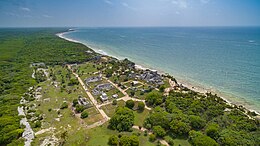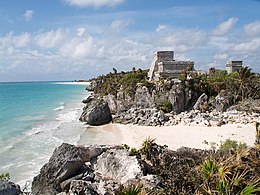Tulum (Mayan site)
Tulum (in Mayathan Tulu'um , "wall" or "fortress") is located on the so-called Riviera Maya , a stretch of coast on the Caribbean coast of Mexico in the state of Quintana Roo , around 130 kilometers south of Cancún .
Tulum is one of those Mayan archaeological sites that lie directly on the sea. The most famous buildings are, besides the so-called “Castle”, the “Temple of the Descending God”, also called “House of Halach Huinik ”, the “Temple of the Wind” and the “Fresco Temple”. The inner city is surrounded by a city wall that is open to the sea, with watchtowers on the north-west and south-west corners. For monument preservation reasons, not all structures are accessible to visitors. Likewise, the site was built for observing the starry sky, especially Venus . The Maya calendar was created in such places and constantly checked. Small window openings still show the orientation and transmission of sun rays at the winter solstice .
history
Settled since around 1200, Tulum was one of the larger cities on the Yucatán Peninsula in the 13th and 14th centuries . Tulum, called Zama in the Chilam Balam texts, was territorially in the Maya jurisdiction of Ekab .
The chaplain and chronicler Juan Díaz , a member of the Spanish Juan de Grijalva expedition, mentioned Tulum as the first European in 1518. He compared the size of the city with that of Seville . Tulum was probably an important trading hub for the Maya because of its favorable location by the sea and had a developed defense system. Tulum was still used as a religious center when the Spaniards arrived.
The first modern visitor to leave a more detailed record was John Lloyd Stephens .
During the Caste War (1847-1901), Tulum was a center of Mayan resistance . Here - similar to Chan Santa Cruz - there was a speaking cross from 1871 , which was guarded by the Mayan priestess María Uicab , the "Queen of Tulum".
Buildings
The entire city area - with the exception of the lake side - enclosed by a right-angled wall with sides of 385 and 165 m was built on with low residential buildings, of which only the base walls can be seen. The larger temples today have descriptive names that are not authentic; the representative roof fronts in the Puuc style are striking . The huts of the common people stood outside the city wall .
- The "castle" (Spanish Castillo ) is the tallest building in Tulum. The Spaniard Juan Díaz considered this tower to be the largest he had ever seen in 1518. The upper building has two vaulted rooms, the three entrances of which are supported by serpentine columns. Their snake heads, no longer preserved, rested on the ground. The rest of the facade frieze is relatively simple.
- The "Temple of the Descending God" (Spanish Templo del Dios Descendente ) got its name from the figure of the Descending God contained in the roof frieze. This deity, depicted several times in Tulum (for example in the castle), was associated with the sunset, rain, lightning and beekeeping and was called Mayathan Ah Mucen Cab (god of bees). On the other hand, the building is also seen as the residence of the ruler ( Halach Huinik ).
- The "Fresco Temple", also "Temple of the Friezes" (Spanish Templo de las Pinturas ), got its name because of the numerous wall paintings of snakes, fish, lizards and other marine animals, which each frame deities. It is believed that the temple was used to worship deities related to the fertility of the soil. The ground floor contains a column and a portico pillar .
- The "Temple of the Wind God" (Spanish Templo del Dios del Viento ) was built on a natural hill in close proximity to the sea. It is built on a semicircular platform and has only one room. The semicircular structure suggests the worship of the wind and represents a construction method that is rare for the Mayan culture. Similar basic architectural structures can be found further west, for example in Uxmal at the " Pyramid of the Magician ".
Others
The city (as it looked in the 18th century) was recreated in the video game Assassin's Creed IV: Black Flag .
See also
Web links
Individual evidence
- ↑ "Maya sites in Quintana Roo: Tulúm" (history), Athena Review Vol. 2, no. 1, 2003, webpage: AthenaPub-Tulum ( Memento of the original from June 25, 2012 in the Internet Archive ) Info: The archive link became automatic used and not yet tested. Please check the original and archive link according to the instructions and then remove this notice. .






